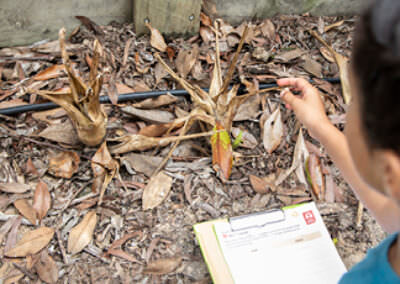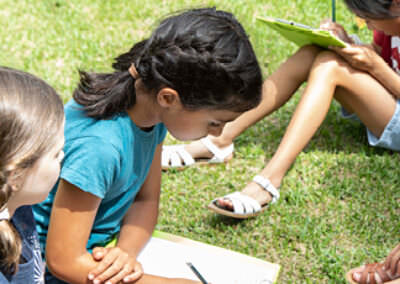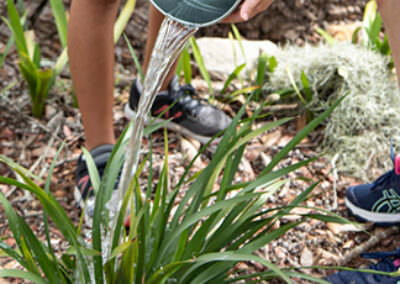STORY
Suyin and her friend Tom love playing in their local park and have been noticing that the grass and all the plants were brown and very dry. When playing on the swings, Tom told Suyin that there was a drought and he was learning why water is important. On their way home, they notice people hosing their driveways and washing their cars on the road. They could see lots of water running down the drains. Suyin was sad that so much water was being wasted. To cheer up his friend, Tom suggested they could look at ways to save water at home and in the garden.

We are going to explore the importance of water. This activity aims to explore water usage and water saving ideas. Every drop counts!
For children to:
- understand the importance of water
- look at ways to help save water
- undertake a water audit.
This activity can be undertaken any time of year.
Introduction
Water is the most common substance found on earth and less that 1% is available as fresh water. Yet all plants and animals need water to survive. We need to conserve and protect fresh water resources. The Every Drop Counts learning activity explores the many ways that water is used, how you can reduce your water usage and reuse water.
*Time allocation will be dependent on site selection and travel time.
Checklist
Instructions

STEP 1
Make a list in the activity sheet of all the ways you use water in your home and garden. Think about what you do each day from morning until night, as well as over a week and a year.
Think about all the ways you use water at home. You might use water for:
- drinking and cooking
- washing, bathing and keeping clean
- watering your garden
- keeping cool and recreation activities.

STEP 2
There are different ways water moves through the urban water cycle and natural water cycle.
Discuss the many ways waters arrives at your house. These may include:
- mains water
- dams
- recycled water
- rain water
- bore water.

STEP 3
Use the Water Usage Table included in the activity sheet or the online Hunter Water: Water Usage Calculator to work out how much water you use each day.

STEP 4
Using the information gathered in Steps 1, 2 and 3, list ways you can save water in your home and garden. Talk as a family about what each of you can do to make a difference.
Every drop counts!
Extension Activity
Design a water wise garden
Water wise plants can cope with low rainfall and are a perfect addition to your garden. Think of what plants are already in your garden. What plants can you add to make a variety of places for animals to shelter? You can also use shallow containers for water, add sticks or stones on one side so smaller animals can get out if they fall in. Contact your local Landcare group for more information about the best plants suited to your local area.
Curriculum and Framework Links
SCIENCE
Year 3: ACSHE050, ACSIS053, ACSIS054, ACSIS057, ACSIS215, ACSIS060
Year 4: ACSSU075, ACSSU073, ACSIS064, ACSIS216, ACSIS071
Year 5: ACSSU043, ACSHE083, ACSIS231, ACSIS086, ACSIS090
Year 6: ACSSU094, ACSSU096, ACSHE098, ACSHE100, ACSIS221, ACSIS110
Year 7: ACSSU112, ACSSU116, ACSHE223, ACSHE120, ACSHE121, ACSIS125, ACSIS133
Year 8: ACSHE135, ACSHE136, ACSIS139, ACSIS145, ACSIS148
GEOGRAPHY
Year 7: ACHGK037, ACHGK038, ACHGK039, ACHGK040, ACHGK042, ACHGS050
Year 8: ACHGK051, ACHGK052, ACHGK053
HUMANITIES, ARTS & SOCIAL SCIENCES
Year 3: ACHASSK072
Year 5: ACHASSK114, ACHASSK118
HEALTH & PHYSICAL EDUCATION
Year 3 & 4: ACPPS035, ACPPS038
Year 5 & 6: ACPPS056
Year 7 & 8: ACPPS073
Reference List
ONLINE RESOURCES
Hunter Water: Water Usage Calculator to calculate how much water you use each year.
Australian Institute for Disaster Resilience
PRINTABLE RESOURCES
Australian Institute for Disaster Resilience
Water Footprint
WATCH
UNESCO WWAP: Where is Water? – The Water Rooms #2
We value your feedback
When you have finished this learning activity, please tell us what you think with our survey.
Your feedback will help Landcare Australia improve the activities in the Junior Landcare Learning Centre.
Why not try one of our other Junior Landcare learning activities?
Creating a butterfly garden
Biodiversity
Love Letters to the Land
Biodiversity|First Nations Perspectives|Food Production|Waste Management
Creating a sensory garden
Biodiversity
Understanding weeds: life cycle
Biodiversity


